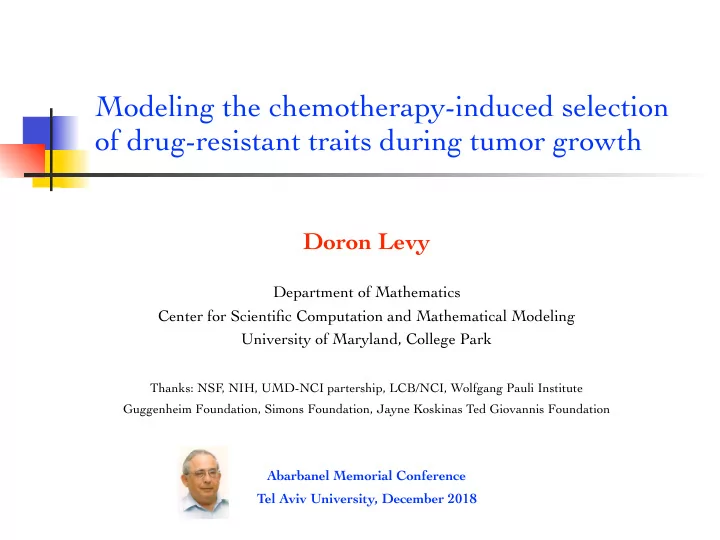

Modeling the chemotherapy-induced selection of drug-resistant traits during tumor growth Doron Levy Department of Mathematics Center for Scientific Computation and Mathematical Modeling University of Maryland, College Park Thanks: NSF, NIH, UMD-NCI partership, LCB/NCI, Wolfgang Pauli Institute Guggenheim Foundation, Simons Foundation, Jayne Koskinas Ted Giovannis Foundation Abarbanel Memorial Conference Tel Aviv University, December 2018
Joint work with Heyrim Cho Michael Gottesman, MD ★ ★ Maryland NCI/NIH Matt Becker Orit Lavi ★ ★ Johns Hopkins APL NCI/NIH Cristian Tomasetti Jim Greene ★ ★ Johns Hopkins Rutgers
Outline Drug Resistance in Cancer ★ Mechanisms of MDR • Mathematics & Drug Resistance • Heterogeneity and Resistance ★ Selection process – a continuous trait • Heterogeneity in space (non-radially symmetric case) • Drug combinations (including cell-cycle and non-cell-cycle specific) • Competition between healthy cells and cancer cells •
Mechanisms of MDR Gillet & Gottesman, 2010
Mathematics and Drug Resistance Lavi, Gottesman, Levy. The dynamics of drug resistance: A mathematical perspective. Drug Resistance Updates 15, 2012, 90-97. Q1: What is the optimal protocol for drug scheduling in terms of dose ★ and timing? Goal: maximize the control of the tumor while minimizing toxicity (Norton & Simon / Goldie & Coldman,…) Q2: Continuous infusion vs. short pulses (Gardner, Panetta, Smieja,…) ★ Q3: When several drugs are available, how many drugs should be used? ★ Should they be used in combination or sequentially? (Komarova & Wodarz,…)
Tumor heterogeneity Experiment: sequence the genome of cells that are sampled from different ★ locations within the tumor Result: the genomes of these cells are different ★ Conclusion: tumors are heterogeneous ★ What does it mean? Different things to different people ★ For us: heterogeneity in response to drugs ★
The genome is not everything! There is more to the dynamics than the genome ★ Genetics vs. epigenetics ★ Example: AMIGOS experimental data (TNBCs, 3D, Peyton lab) ★
The ultimate goal Assumptions (science fiction): ★ We can know the initial data (mapping the entire tumor with regards to • the level of resistance) We can fully control the treatment (which drug and how much of it • arrives at what area) We can fully (and dynamically) know what the cells are doing without • the treatment and in response to the treatment Question: What is the optimal treatment? ★ A preliminary question: What is “optimal”? ★
Modeling Tumor Heterogeneity (Greene, Lavi, Gottesman, DL, Cancer Research 2013, BMB 2014, Trends in Mol. Med. 2014) Following Lorz, Lorenzi, Clairambault, Perthame, et al. 2013 (Calsina & Cuadrado, Champagnat, Desvillettes, Diekmann, …) ∂ n ( x, t ) ⇣ ⌘ = f ( ρ ( t ))[ r ( x )(1 − θ ( x )) − h ( D ( t ) , x )] − g ( ρ ( t )) d ( x ) n ( x, t ) ∂ t Z 1 Z 1 + f ( ρ ( t )) θ ( y ) r ( y ) M ( y, x ) n ( y, t ) d y. ρ ( t ) = n ( x, t ) d x. 0 0 After some scaling…. And assuming D ( t ) ≡ 1 , θ ( x ) ≡ θ Z 1 ∂ n ( x, t ) = ( r ( x )(1 − θ ) − c ( x ) − G ( ρ ( τ )) d ( x )) n ( x, t ) + θ r ( y ) M ( y, x ) n ( y, t ) dy ∂ t 0 Resistance level is assumed to be a continuous parameter
Modeling Tumor Heterogeneity Z t Under these assumptions + rescaling time τ = f ( ρ ( s )) d s ★ 0 Z 1 ∂ n ( x, t ) = ( r ( x )(1 − θ ) − c ( x ) − G ( ρ ( τ )) d ( x )) n ( x, t ) + θ r ( y ) M ( y, x ) n ( y, t ) dy ∂ t 0 Case I: Trait-based growth ★ ∂ n ( x, t ) = [ r ( x ) − c ( x ) − d ( x )] n ( x, t ) . Lorz - cancer cells ∂ t Case II: Density-dependent model ★ ∂ n ( x, t ) Lorz - a specific form = [ r ( x ) − c ( x ) − G ( ρ ) d ( x )] n ( x, t ) . of the eq. for healthy cells ∂ t Case III: The full selection-mutation model ★
<latexit sha1_base64="85D5pPO+bYK3s+8uads8MAEiGoA=">ACSHicbVBNT9swGHa6DUrZWNmOXCwqpFZiVYImwRFplx2LRAGpqaI3jtNaOHaw30CrKD9vF47c9hu4cGBC3HBLDnzskSw9ej5k+4lzKSz6/l+v8eHjp5XV5lpr/fOXja/tzW8nVheG8SHTUpuzGCyXQvEhCpT8LDcsljy0/j818I/veTGCq2OcZ7zcQYTJVLBAJ0UtaPQTHUXezQ0YjJFMEZf0VCoFOe7NLwoIKFhaoCVqjvbxV5V1vnqdcEWVSKikIkaJhwidCd/ZhFohe1O37fX4K+J0FNOqTGIGrfhIlmRcYVMgnWjgI/x3EJBgWTvGqFheU5sHOY8JGjCjJux+VyiIruOCWhqTbuKRL9WjhMzaeRa7ZAY4tW+9hfg/b1RgejAuhcoL5Io9X5QWkqKmi1VpIgxnKOeOADPCvZWyKbjd0G3fciMEb7/8npzs9QO/Hxz97Bzu1XM0yRbZJl0SkH1ySH6TARkSRv6QW3JP/nX3p34D0+Rxte3flOXqHReAKCb7Ie</latexit> <latexit sha1_base64="85D5pPO+bYK3s+8uads8MAEiGoA=">ACSHicbVBNT9swGHa6DUrZWNmOXCwqpFZiVYImwRFplx2LRAGpqaI3jtNaOHaw30CrKD9vF47c9hu4cGBC3HBLDnzskSw9ej5k+4lzKSz6/l+v8eHjp5XV5lpr/fOXja/tzW8nVheG8SHTUpuzGCyXQvEhCpT8LDcsljy0/j818I/veTGCq2OcZ7zcQYTJVLBAJ0UtaPQTHUXezQ0YjJFMEZf0VCoFOe7NLwoIKFhaoCVqjvbxV5V1vnqdcEWVSKikIkaJhwidCd/ZhFohe1O37fX4K+J0FNOqTGIGrfhIlmRcYVMgnWjgI/x3EJBgWTvGqFheU5sHOY8JGjCjJux+VyiIruOCWhqTbuKRL9WjhMzaeRa7ZAY4tW+9hfg/b1RgejAuhcoL5Io9X5QWkqKmi1VpIgxnKOeOADPCvZWyKbjd0G3fciMEb7/8npzs9QO/Hxz97Bzu1XM0yRbZJl0SkH1ySH6TARkSRv6QW3JP/nX3p34D0+Rxte3flOXqHReAKCb7Ie</latexit> <latexit sha1_base64="85D5pPO+bYK3s+8uads8MAEiGoA=">ACSHicbVBNT9swGHa6DUrZWNmOXCwqpFZiVYImwRFplx2LRAGpqaI3jtNaOHaw30CrKD9vF47c9hu4cGBC3HBLDnzskSw9ej5k+4lzKSz6/l+v8eHjp5XV5lpr/fOXja/tzW8nVheG8SHTUpuzGCyXQvEhCpT8LDcsljy0/j818I/veTGCq2OcZ7zcQYTJVLBAJ0UtaPQTHUXezQ0YjJFMEZf0VCoFOe7NLwoIKFhaoCVqjvbxV5V1vnqdcEWVSKikIkaJhwidCd/ZhFohe1O37fX4K+J0FNOqTGIGrfhIlmRcYVMgnWjgI/x3EJBgWTvGqFheU5sHOY8JGjCjJux+VyiIruOCWhqTbuKRL9WjhMzaeRa7ZAY4tW+9hfg/b1RgejAuhcoL5Io9X5QWkqKmi1VpIgxnKOeOADPCvZWyKbjd0G3fciMEb7/8npzs9QO/Hxz97Bzu1XM0yRbZJl0SkH1ySH6TARkSRv6QW3JP/nX3p34D0+Rxte3flOXqHReAKCb7Ie</latexit> <latexit sha1_base64="85D5pPO+bYK3s+8uads8MAEiGoA=">ACSHicbVBNT9swGHa6DUrZWNmOXCwqpFZiVYImwRFplx2LRAGpqaI3jtNaOHaw30CrKD9vF47c9hu4cGBC3HBLDnzskSw9ej5k+4lzKSz6/l+v8eHjp5XV5lpr/fOXja/tzW8nVheG8SHTUpuzGCyXQvEhCpT8LDcsljy0/j818I/veTGCq2OcZ7zcQYTJVLBAJ0UtaPQTHUXezQ0YjJFMEZf0VCoFOe7NLwoIKFhaoCVqjvbxV5V1vnqdcEWVSKikIkaJhwidCd/ZhFohe1O37fX4K+J0FNOqTGIGrfhIlmRcYVMgnWjgI/x3EJBgWTvGqFheU5sHOY8JGjCjJux+VyiIruOCWhqTbuKRL9WjhMzaeRa7ZAY4tW+9hfg/b1RgejAuhcoL5Io9X5QWkqKmi1VpIgxnKOeOADPCvZWyKbjd0G3fciMEb7/8npzs9QO/Hxz97Bzu1XM0yRbZJl0SkH1ySH6TARkSRv6QW3JP/nX3p34D0+Rxte3flOXqHReAKCb7Ie</latexit> Case I: Trait-Based Growth n ( x, t ) ∂ n ( x, t ) X ρ ( t ) → ∞ , a i δ ( x − x i ) = [ r ( x ) − c ( x ) − d ( x )] n ( x, t ) . → ρ ( t ) ∂ t i Only two different growth phenomena: extinction or unbounded growth ★ Yet - a selection model: a selection of the traits with the maximum net ★ growth rate (the x’ s that maximize r(x)-c(x)-d(x) ) 60 2 t=0 r(x) t=1.3442 1.8 c(x) t=25 d(x) 50 1.6 1.4 40 n(x,t)/ ρ (t) 1.2 1 30 0.8 20 0.6 0.4 10 0.2 0 0 0 0.2 0.4 0.6 0.8 1 0 0.2 0.4 0.6 0.8 1 x x
Recommend
More recommend